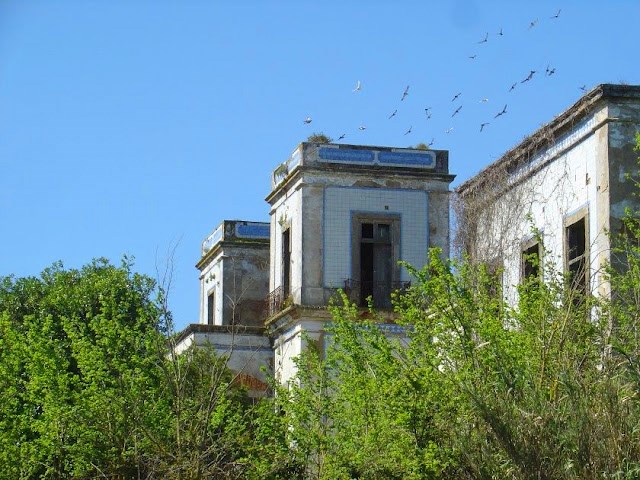FOR ENGLISH CLICK HERE

Palácio do Farrobo


O palácio de Farrobo, actualmente propriedade da Santa Casa da Misericórdia de Vila Franca de Xira, foi edificado na Quinta com o mesmo nome, que resultou da junção de diversas propriedades rústicas, instituídas em morgadio em 1801, e que haviam sido adquiridas pelo seu primeiro proprietário, Joaquim Pedro Quintela (1748-1817), 1º barão de Quintela. Foi, no entanto, o seu filho e homónimo, 2º barão de Quintela e 1º conde de Farrobo, quem edificou, em 1835, o palácio que hoje conhecemos. Nascido em Lisboa em 1801, Joaquim Pedro Quintela destacou-se por ser um apoiante de D. Pedro IV, que o recompensou com o título de Conde de Farrobo (1833) após a vitória liberal. As suas qualidades artísticas e a imensa fortuna que possuía celebrizaram o seu palácio lisboeta, situado nas Laranjeiras, onde decorreram festas memoráveis e onde existia um teatro, palco de diversas e significativas representações. Para além de muitos outros títulos e funções, o conde de Farrobo foi empresário do Teatro Nacional São Carlos, por onde passaram importantes artistas da época.
A sua Quinta de Vila Franca de Xira funcionava como uma espécie de retiro de lazer, onde o conde produzia vinho, organizava caçadas, e grandiosas festas, convidando a alta burguesia e a nobreza lisboeta.
Não se conhece, ao certo, o arquitecto do palácio, embora o nome de Fortunato Landi surja como uma atribuição possível. O imóvel desenvolve-se em planta rectangular, onde se destacam os volumes dos corpos laterais e central, avançados em relação aos restantes. No alçado principal, duas torres flanqueiam um corpo central, mais baixo, de dois andares (como os restantes), precedido por uma escadaria de lanços convergentes, paralelos à fachada. Estes permitem o acesso à loggia do andar nobre. Todo o pano murário é aberto por uma série de vãos simétricos, com janelas no piso térreo e de sacada no andar superior.
No alçado posterior é ainda visível o corpo do antigo teatro que também aqui existia, e que deveria ser uma réplica do de São Carlos. Os interiores encontram-se hoje bastante adulterados, pois os azulejos, pinturas e outros bens desapareceram durante a década de 1970.
De facto, após a morte de Joaquim Pedro Quintela em 1869, a Quinta foi vendida em hasta pública (uma vez que nos últimos anos de vida o conde sofreu um forte abalo financeiro) e, desde a segunda metade do século XX, é visível a degradação que se foi acentuando até à actualidade. Nos anos 70 foi doado à Caritas, e nessa época estaria ainda em relativo estado de conservação mas, de acordo com o provedor da Misericórdia, o palácio foi abandonado depois do 25 de Abril de 1974.
A CACHE:
Trata-se de um contentor pequeno um pouco maior que um rolo de fotografia. Inicialmente terá stashnote/logbook, folheto sobre geocaching, e caneta.
Por favor sê discreto na procura da cache e deixa-a exactamente no local onde a encontraste.
Não se recomenda que entrem na quinta pois é propriedade privada.


The Palace of Farrobo, currently owned by Santa Casa da Misericórdia of Vila Franca de Xira, was built in the farm with the same name, which resulted from the junction of several other rural farms in 1801 and had been acquired by its first owner, Joaquim Pedro Quintela (1748-1817), the 1st Baron of Quintela.
It was, however, his son and namesake, the 2nd Baron of Quintela and 1st Earl of Farrobo, who built in 1835 the palace as we know it today. Born in Lisbon in 1801, Joaquim Pedro Quintela stood out for being a supporter of D. Pedro IV, the king of Portugal, who rewarded him with the title of Earl of Farrobo (1833) after the liberal victory. His artistic qualities and immense fortune made famous his palace in Lisbon, located in Laranjeiras, where several memorable parties took place and where there was a theater, stage of various performances. In addition to many other titles and functions, the Earl of Farrobo was the manager of the Teatro Nacional São Carlos (national theatre), where famous artists of the time performed.
His farm in Vila Franca de Xira functioned as a sort of retreat for leisure, where the Earl produced wine, organized hunts and magnificent parties, inviting the high bourgeoisie and the nobility of Lisbon.
No one knows for sure who was the architect of the palace, though the name of Fortunato Landi emerge as a possible architect. The property is developed in a rectangular plan, which highlights the volumes of the lateral and central bodies more advanced compared to the others. In the main elevation, two towers are flanking a central body, lower, with two floors (just as the others), preceded by a staircase with converging sections, parallel to the facade. These provide access to the "loggia" of the nobel floor. All the main walls have symmetrical openings with windows on the ground floor and of balcony upstairs. It is still visible the body of the old theater that also existed here, and that should be a replica of Teatro Nacional São Carlos. The interiors are now quite vandalized, because the tiles, paintings and other goods disappeared during the 1970s. In fact, after the death of Joaquim Pedro Quintela in 1869, the farm was sold at auction (once in the last years of life the Earl suffered a major financial shock) and, since the second half of the 20th century, it suffered a degradation thaw has been growing until the present years. In the 70s it was donated to Caritas, and at that time it was still on a good conservation status, but according to Santa Casa da Misericórdia, the palace was abandoned after the revolution on April 25, 1974.
THE CACHE:
It's a small container. In the beginning you'll find a stashnote/logbook, geocaching brochure and pen.
Please be discreet in searching for the cache and leave it exactly where you found it.
It's not recommended to enter the farm because it is a private property.



